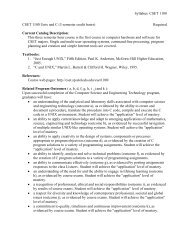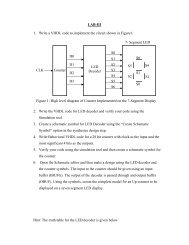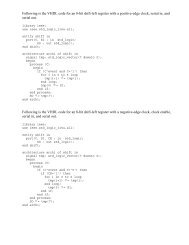Programmable Logic and Application Specific Integrated Circuits
Programmable Logic and Application Specific Integrated Circuits
Programmable Logic and Application Specific Integrated Circuits
Create successful ePaper yourself
Turn your PDF publications into a flip-book with our unique Google optimized e-Paper software.
In the Actel ACT family FPGAs a logic module matrix is arranged as rows of cells<br />
separated by horizontal wiring channels, as previously illustrated in Figure 10.B. This<br />
organization is similar to that found in the traditional style of Mask Programmed Gate Arrays<br />
(MPGAs). Vertical interconnect segments of varying lengths are available. Vertical segments in<br />
input tracks are permanently connected to logic module inputs, <strong>and</strong> vertical segments in output<br />
tracks are permanently connected to logic module outputs. Long vertical segments are available<br />
which are uncommitted <strong>and</strong> can be assigned during routing. The horizontal wiring channel<br />
resources are also segmented into varying lengths. The minimum horizontal segment length is the<br />
width of a single logic module, <strong>and</strong> the maximum horizontal segment length spans the full channel.<br />
Any segment that spans more than one-third of the row length is considered a “long horizontal<br />
segment”. Connections between interconnect segments are permanently formed using the PLICE<br />
antifuse which was described earlier in this chapter. Dedicated routing tracks are used for global<br />
clock distribution <strong>and</strong> for power <strong>and</strong> ground tie-off connections. Actel has three generations of<br />
FPGAs, denoted ACT1, ACT2, <strong>and</strong> ACT3 16 , whose characteristics are listed in Table 7.<br />
Family Series Number of<br />
User I/O<br />
Table 7. ACTEL FPGA Family Characteristics<br />
Number of<br />
<strong>Logic</strong> Modules<br />
26<br />
Number of<br />
FFs<br />
Typical Gate-Array<br />
Equivalent Gates<br />
ACT-1 57-69 295-547 147-273 1,200-2,000<br />
ACT-2 83-140 451-1,232 382-998 2,500-8,000<br />
ACT-3 80-228 200-1,377 264-1,153 1,500-10,000<br />
In contrast to the Xilinx FPGA which uses a relatively complex CLB cell, the Actel<br />
approach uses small <strong>and</strong> simple logic modules. This does not imply that the Actel design has<br />
inherent disadvantages compared to the Xilinx approach. Research by Singh et. al. has shown that<br />
both of these approaches have merit. 17 Their results indicate that the best choice for a<br />
programmable block depends on the speed performance <strong>and</strong> the area requirements of the routing<br />
architecture. The low-impedance <strong>and</strong> small area Actel antifuse structure is better suited for use<br />
with a simple logic module; whereas the larger area <strong>and</strong> higher resistance Xilinx SRAM<br />
controlled transistor switch is more appropriate for a complex logic cell.<br />
The ACT1 family <strong>Logic</strong> Module (LM) is an 8-input, one output function which can be used<br />
to construct the four primitive logic function (AND, OR, NAND, NOR) with two through four<br />
inputs. Figure 15 shows how the basic ACT1 <strong>Logic</strong> Module circuit uses multiplexers to create<br />
programmable logic functions. The LMs can also be used to construct latches, flip-flops, XORs,<br />
AND-ORs <strong>and</strong> other logic structures. Actel does not include dedicated hardwired latches or flipflops<br />
in the ACT1 array since they can be constructed from LMs wherever needed in the design.<br />
The ACT1 family uses 22 metal signal wiring tracks in each horizontal channel <strong>and</strong> 13 vertical<br />
tracks that lie on top of each column of LMs.
















